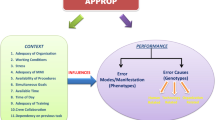Abstract
In this study, the relative importance of significant performance shaping factors (PSFs), which is critical for estimating the human error probability (HEP) of a given task environment is extracted from event investigation reports of domestic nuclear power plants (NPPs). Each event was caused by one or more human performance related problems (i.e., human errors), and its investigation report includes detailed information describing why the corresponding event has occurred. Based on 10 event reports, 47,220 data records were identified, which represent the task environment of 11 human errors in terms of significant PSFs. After that, the relative importance of the associated PSFs was analyzed by using a CART (Classification and Regression Tree) method that is one of the representative techniques to scrutinize the characteristics of big data.
Access this chapter
Tax calculation will be finalised at checkout
Purchases are for personal use only
Similar content being viewed by others
References
International Atomic Energy Agency (IAEA): Collection and Classification of Human Reliability Data for Use in Probabilistic Safety Assessments. IAEA-TECDOC-1048, Vienna (1998)
Nuclear Energy Agency (NEA): HRA Data and Recommended Actions to Support the Collection and Exchange of HRA Data. Report of Working Group on Risk Assessment, NEA/CSNI/R(2008)9 (2008)
Operational Performance Information System (OPIS). http://www.opis.kins.re.kr
Park, J., Kim, Y., Jung, W.: Application of the HuREX Framework for Calculating Empirical Human Error Probabilities from the Operation Experience of Domestic Nuclear Power Plants – Preliminary Results. KAERI/TR-6474, Korea Atomic Energy Research Institute, Daejeon, Republic of Korea (2016)
Park, J., Kim, Y., Jung, W.: A Framework to Estimate HEPs from the Full-scope Simulators of NPPs: Unsafe Act Definition, Identification and Quantification. KAERI/TR-6401, Korea Atomic Energy Research Institute, Daejeon, Republic of Korea (2016)
Shmueli, G., Patel, N.R., Bruce, P.C.: Data Mining for Business Intelligence. Wiley, New Jersey (2010)
Barriere, M., Bley, D., Cooper, S., Forester, J., Kolaczkowski, A., Luckas, W., Parry, G., Ramey-Smith, A., Thompson, C., Whitehead, D., Wreathall, J.: Technical Basis and Implementation Guidelines for a Technique for Human Event Analysis (ATHEANA). NUREG-1624, Rev. 1, U.S. Nuclear Regulatory Commission, Washington DC (2000)
Lois, E., Dang, V.N., Forester, J., Broberg, H., Massaiu, S., Hildebrandt, M., Braarud, P.Ø., Parry, G., Julius, J., Boring, R., Männistö, I., Bye, A.: International HRA Empirical Study – Description of Overall Approach and Pilot Phase Results from Comparing HRA Methods to Simulator Performance Data. NUREG/IA-2016, vol. 1, U.S. Nuclear Regulatory Commission, Washington, DC (2009)
Author information
Authors and Affiliations
Corresponding author
Editor information
Editors and Affiliations
Rights and permissions
Copyright information
© 2018 Springer International Publishing AG
About this paper
Cite this paper
Park, J., Kim, Y., Jung, W. (2018). Use of a Big Data Mining Technique to Extract Relative Importance of Performance Shaping Factors from Event Investigation Reports. In: Boring, R. (eds) Advances in Human Error, Reliability, Resilience, and Performance. AHFE 2017. Advances in Intelligent Systems and Computing, vol 589. Springer, Cham. https://doi.org/10.1007/978-3-319-60645-3_23
Download citation
DOI: https://doi.org/10.1007/978-3-319-60645-3_23
Published:
Publisher Name: Springer, Cham
Print ISBN: 978-3-319-60644-6
Online ISBN: 978-3-319-60645-3
eBook Packages: EngineeringEngineering (R0)




